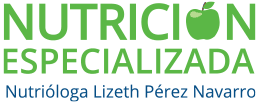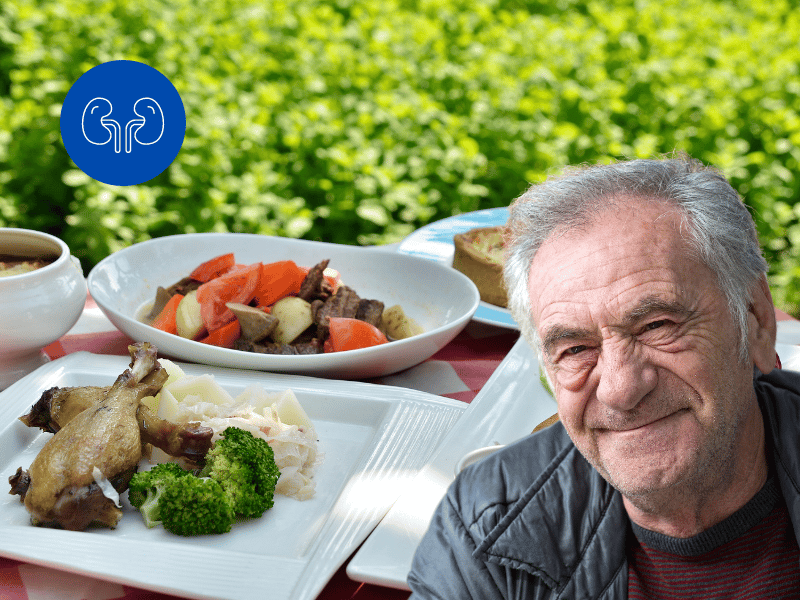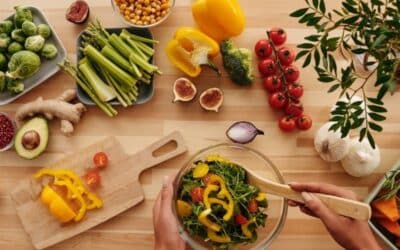You may need to change what you eat to manage your chronic kidney disease (CKD). Seek help from a certified nutritionist or renal nutrition expert to develop an eating plan that includes foods you enjoy while maintaining kidney health.
The following steps will help you eat well while managing your kidney disease. The first three steps (1-3) are important for all people with kidney disease. The last two steps (4-5) may become important as kidney function declines.
The First Steps to Eating Well
Step 1: Choose and prepare foods with less salt and sodium
Why? To help control your blood pressure. Your diet should contain less than 2,000 milligrams of sodium per day.
- Buy fresh foods frequently. Sodium (a component of salt) is added to many prepared or packaged foods you buy at the grocery store or restaurants.
- Cook foods from scratch instead of eating prepared foods, fast food, frozen dinners, and canned foods high in sodium. When you prepare your own food, you control what’s in it.
- Use sodium-free spices, herbs, and seasonings instead of salt.
- Check the sodium on the nutrition label of food packages. A daily value of 20 percent or more means the food is high in sodium.
- Try low-sodium versions of frozen dinners and other prepared foods.
- Rinse canned vegetables, beans, meats, and fish with water before eating them.
Look for food labels with words like “sodium-free” or “salt-free,” or “low,” “reduced,” or “no salt” or “sodium,” or “lightly salted.”
Look for sodium on food labels. A food label showing a daily percentage value of 5% or less is low in sodium. Also, look for the amount of saturated and trans fats listed on the label.
Step 2: Consume the right amount and types of protein
Why? To help protect your kidneys. When your body uses proteins, it produces waste. Your kidneys eliminate this waste. Eating more protein than you need can make your kidneys work harder.
- Consume small portions of protein-containing foods.
- Protein is found in both plant and animal foods. Most people ingest both types of proteins. Talk to your nutritionist about choosing the right combination of protein foods for you.
Animal protein foods:
- Chicken
- Fish
- Meat
- Eggs
- Dairy products
Plant-based protein foods:
- Beans
- Nuts
- Grains
Beans Nuts Grains A serving of cooked beans is approximately ½ cup, and a serving of nuts is ¼ cup. A serving of bread is a single slice, and a serving of cooked rice or pasta is ½ cup.
Step 3: Choose foods that are healthy for your heart
Why? To help prevent fat from building up in blood vessels, the heart, and the kidneys.
- Grilling, baking, or stir-frying foods is a better option than frying them.
- Cook with nonstick cooking spray or a small amount of olive oil instead of butter.
- Trim fat from meat and remove the skin from poultry before eating.
- Try to limit saturated and trans fats. Read food labels.
Heart-healthy foods:
- Lean cuts of meat, such as loin or round
- Skinless poultry
- Fish
- Beans
- Vegetables
- Fruits
- Low-fat or fat-free milk, yogurt, and cheese
Choose heart-healthy foods that help protect your blood vessels, heart, and kidneys.
Limit alcohol
Drinking alcohol can damage the liver, heart, and brain and cause serious health problems.
The Next Steps to Eating Well.
As your kidney function declines, you may need to eat foods with less phosphorus and potassium. Your treating doctor will use laboratory tests to check phosphorus and potassium levels in your blood, and you can work with your nutritionist to adjust your eating plan.
Step 4: Choose foods and drinks with less phosphorus
Why? To help protect your bones and blood vessels. When you have CKD, phosphorus can build up in the blood. Too much phosphorus in the blood draws calcium from the bones, making them thin, weak, and more prone to breakage. High levels of phosphorus in the blood can also cause itching of the skin and bone and joint pain.
- Many packaged foods contain added phosphorus. Look for phosphorus or words with “PHOS” on ingredient labels.
- Cold cuts and some fresh meats and poultry may have added phosphorus. Ask the butcher to help you choose fresh meats without added phosphorus.
Low-phosphorus foods:
- Fresh fruits and vegetables
- Breads, pasta, rice
- Rice milk (unenriched)
- Rice milk (not enriched) Corn and rice cereals Clear
Sodas or drinks, such as lime-lemon or homemade iced tea
High-phosphorus foods:
- Meat, poultry, fish
- Bran and oat cereals
- Dairy products
- Beans, lentils, nuts
Dark-colored sodas, fruit punch, some bottled or canned iced teas with added phosphorus
Your treating doctor can talk to you about the possibility of taking a phosphate binder with meals to reduce the amount of phosphorus in your blood. A phosphate binder is a medication that acts like a sponge to absorb or bind phosphorus while it’s in the stomach. Because it’s bound, the phosphorus doesn’t enter your bloodstream. Instead, your body eliminates the phosphorus through the stool.
Step 5: Choose foods with the right amount of potassium
Why? To help your nerves and muscles function properly. Problems can occur when potassium levels in the blood are too high or too low. Damaged kidneys allow potassium to build up in the blood, which can cause serious heart problems. Your food and beverage choices can help reduce your potassium level if necessary.
- Salt substitutes can be high in potassium. Read the ingredient label. Consult with your nutritionist about using salt substitutes.
- Drain canned fruits and vegetables before eating them.
Low Potassium Foods
- Apples, peaches
- Carrots
- White bread and pasta
- White rice
- Rice milk (unenriched)
- Cooked rice and wheat cereals, semolina
Apple, grape, or cranberry juice
High Potassium Foods
- Oranges, bananas, and orange juice.
- Potatoes, tomatoes
- Brown and wild rice
- Bran cereals
- Dairy products
- Whole wheat bread and pasta
Beans and nuts
Some medications can also elevate your potassium level. Your treating doctor can adjust the medications you take.
Don’t forget to follow an appropriate meal plan; it should be unique and personalized.






